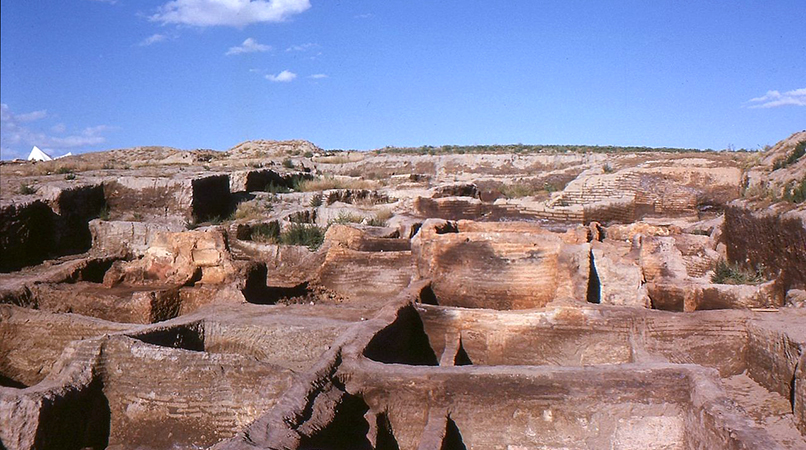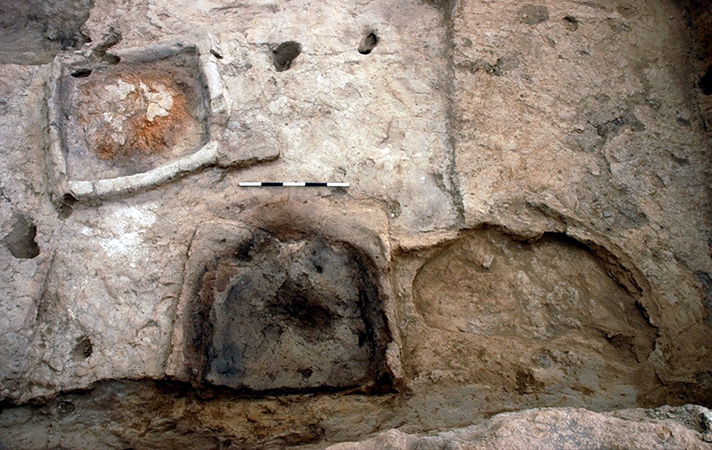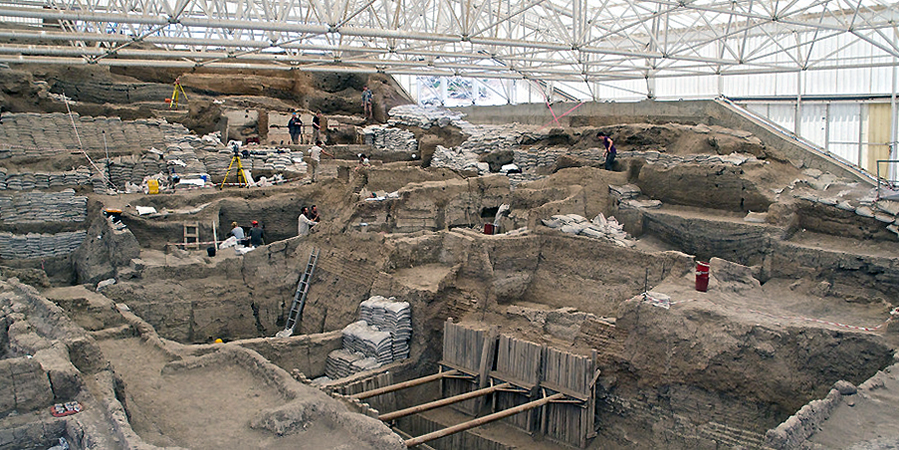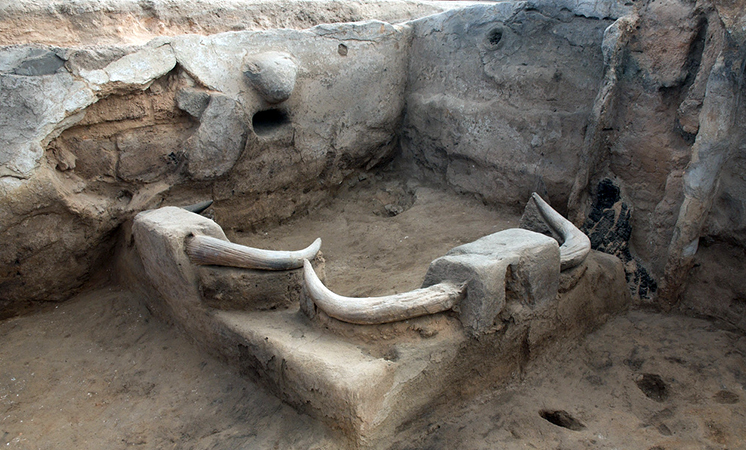The Neolithic Revolution: A Settled Life
When people think of the Neolithic era, they often think of Stonehenge, the iconic image of this early time. Dating to approximately 3000 BCE and set on Salisbury Plain in England, it is a structure larger and more complex than anything built before it in Europe. Stonehenge is an example of the cultural advances brought about by the Neolithic revolution—the most important development in human history. The way we live today, settled in homes, close to other people in towns and cities, protected by laws, eating food grown on farms, and with leisure time to learn, explore and invent is all a result of the Neolithic revolution, which occurred approximately 11,500-5,000 years ago. The revolution which led to our way of life was the development of the technology needed to plant and harvest crops and to domesticate animals.
Before the Neolithic revolution, it’s likely you would have lived with your extended family as a nomad, never staying anywhere for more than a few months, always living in temporary shelters, always searching for food and never owning anything you couldn’t easily pack in a pocket or a sack. The change to the Neolithic way of life was huge and led to many of the pleasures (lots of food, friends and a comfortable home) that we still enjoy today.
The massive changes in the way people lived also changed the types of art they made. Neolithic sculpture became bigger, in part, because people didn’t have to carry it around anymore; pottery became more widespread and was used to store food harvested from farms. Alcohol was first produced during this period and architecture, as well as its interior and exterior decoration, first appears. In short, people settled down and began to live in one place, year after year.
It seems very unlikely that Stonehenge could have been made by earlier, Paleolithic, nomads. It would have been a waste to invest so much time and energy building a monument in a place to which they might never return or might only return infrequently. After all, the effort to build it was extraordinary. Stonehenge is approximately 320 feet in circumference and the stones which compose the outer ring weigh as much as 50 tons; the small stones, weighing as much as 6 tons, were quarried from as far away as 450 miles. The use or meaning of Stonehenge is not clear, but the design, planning and execution could have only been carried out by a culture in which authority was unquestioned. Here is a culture that was able to rally hundreds of people to perform very hard work for extended periods of time. This is another characteristic of the Neolithic era.
Neolithic Settlements: Jericho and Çatalhüyük,
The site of Jericho, just north of the Dead Sea and due west of the Jordan River, is one of the oldest continuously lived-in cities in the world. The reason for this may be found in its Arabic name, Ārīḥā, which means fragrant; Jericho is a natural oasis in the desert where countless freshwater springs can be found. This resource, which drew its first visitors between 10,000 and 9000 BCE, still has descendants that live there today.

Biblical reference
The site of Jericho is best known for its identity in the Bible and this has drawn pilgrims and explorers to it as early as the 4th century CE; serious archaeological exploration didn’t begin until the latter half of the 19th century. What continues to draw archaeologists to Jericho today is the hope of finding some evidence of the warrior Joshua, who led the Israelites to an unlikely victory against the Canaanites (“the walls of the city fell when Joshua and his men marched around them blowing horns” Joshua 6:1-27). Although unequivocal evidence of Joshua himself has yet to be found, what has been uncovered are some 12,000 years of human activity.
The most spectacular finds at Jericho, however, do not date to the time of Joshua, roughly the Bronze Age (3300-1200 BCE), but rather to the earliest part of the Neolithic era, before even the technology to make pottery had been discovered.

Old walls
The site of Jericho rises above the wide plain of the Jordan Valley, its height the result of layer upon layer of human habitation, a formation called a Tell. The earliest visitors to the site who left remains (stone tools) came in the Mesolithic period (around 9000 BCE) but the first settlement at the site, around the Ein as-Sultan spring, dates to the early Neolithic era, and these people, who built homes, grew plants and kept animals, were among the earliest to do such anywhere in the world. Specifically, in the Pre-Pottery Neolithic A levels at Jericho (8500-7000 BCE), archaeologists found remains of a very large settlement of circular homes made with mud-brick and topped with domed roofs.
As the name of this era implies, these early people at Jericho had not yet figured out how to make pottery, but they made vessels out of stone, wove cloth and for tools were trading for a particularly useful kind of stone, obsidian, from as far away as Çiftlik, in eastern Turkey. The settlement grew quickly and, for reasons unknown, the inhabitants soon constructed a substantial stone wall and exterior ditch around their town, complete with a stone tower almost eight meters high, set against the inner side of the wall. Theories as to the function of this wall range from military defence to keeping out animal predators to even combating the natural rising of the level of the ground surrounding the settlement. However, regardless of its original use, here we have the first version of the walls Joshua so ably conquered some six thousand years later.
The Neolithic period is also important because it is when we first find good evidence for religious practice, a perpetual inspiration for the fine arts. Perhaps most fascinating are the plaster skulls found around the area of the Levant, at six sites, including Jericho. At this time in the Neolithic, c. 7000-6,000 BCE, people were often buried under the floors of homes, and in some cases, their skulls were removed and covered with plaster in order to create very life-like faces, complete with shells inset for eyes and paint to imitate hair and mustaches.
The traditional interpretation of these skulls has been that they offered a means of preserving and worshiping male ancestors. However, recent research has shown that among the sixty-one plastered skulls that have been found, a generous number of which come from the bodies of women and children. Perhaps the skulls are not so much religious objects but, rather, powerful images made to aid in mourning lost loved ones. Neolithic peoples didn’t have written language, so we may never know what their creators intended. (The earliest example of writing develops in Sumer in Mesopotamia in the late 4th millennium BCE However, there are scholars that believe that earlier proto-writing developed during the Neolithic period).


Çatalhöyük had no streets or footpaths; the houses were built right up against each other and the people who lived in them travelled over the town’s rooftops and entered their homes through holes in the roofs, climbing down a ladder. Communal ovens were built above the homes of Çatalhöyük and we can assume group activities were performed in this elevated space as well.

Like at Jericho, the deceased were placed under the floors or platforms in houses and sometimes their skulls were removed and plastered to resemble live faces. The burials at Çatalhöyük show no significant variations, either based on wealth or gender; the only bodies which were treated differently, decorated with beads and covered with ochre, were those of children. The excavator of Çatalhöyük believes that this special concern for youths at the site may be a reflection of the society becoming more sedentary and required larger numbers of children because of increased labour, exchange and inheritance needs.

Art is everywhere among the remains of Çatalhöyük, geometric designs as well as representations of animals and people. Repeated lozenges and zigzags dance across smooth plaster walls, people are sculpted in clay, pairs of leopards are formed in relief facing one another at the sides of rooms, hunting parties are painted baiting a wild bull. The volume and variety of art at Çatalhöyük is immense and must be understood as a vital, functional part of the everyday lives of its ancient inhabitants.
Nearly every house excavated at Çatalhöyük was found to contain decorations on its walls and platforms, most often in the main room of the house. Moreover, this work was constantly being renewed; the plaster of the main room of a house seems to have been redone as frequently as every month or season. Both geometric and figural images were popular in two-dimensional wall painting and the excavator of the site believes that geometric wall painting was particularly associated with adjacent buried youths.

Figural paintings show the animal world alone, such as, for instance, two cranes facing each other standing behind a fox, or in interaction with people, such as a vulture pecking at a human corpse or hunting scenes. Wall reliefs are found at Çatalhöyük with some frequency, most often representing animals, such as pairs of animals facing each other and human-like creatures. These latter reliefs, alternatively thought to be bears, goddesses or regular humans, are always represented splayed, with their heads, hands and feet removed, presumably at the time the house was abandoned.

The most remarkable art found at Çatalhöyük, however, are the installations of animal remains and among these the most striking are the bull bucrania. In many houses the main room was decorated with several plastered skulls of bulls set into the walls (most common on East or West walls) or platforms, the pointed horns thrust out into the communal space. Often the bucrania would be painted ochre red. In addition to these, the remains of other animals’ skulls, teeth, beaks, tusks or horns were set into the walls and platforms, plastered and painted. It would appear that the ancient residents of Çatalhöyük were only interested in taking the pointy parts of the animals back to their homes!
How can we possibly understand this practice of interior decoration with the remains of animals? A clue might be in the types of creatures found and represented. Most of the animals represented in the art of Çatalhöyük were not domesticated; wild animals dominate the art at the site. Interestingly, examinations of bone refuse shows that the majority of the meat which was consumed was of wild animals, especially bulls. The excavator believes this selection in art and cuisine had to do with the contemporary era of increased domestication of animals and what is being celebrated are the animals which are part of the memory of the recent cultural past, when hunting was much more important for survival.
Neolithic Monuments
Neolithic art in Western Europe is best represented by its megalithic (large stone) monuments. Also known as the New Stone Age, the Neolithic period in human development lasted from around 10,000 BCE until 3,000 BCE. Considered the last part of the Stone Age, the Neolithic is signified by a progression in behavioural and cultural characteristics including the cultivation of wild and domestic crops and the use of domesticated animals.
Agrarian societies first appeared in southeast Europe in the seventh millennium BCE. Through migration and cultural diffusion, Neolithic traditions spread to northwestern Europe by around 4500 BCE. The development of agriculture allowed groups of people to form larger permanent settlements in single locations, as opposed to living as nomadic hunter-gatherers. Permanent settlements resulted in the construction of megalithic monuments requiring considerable time and effort that was unavailable to nomads.
Megalithic Henges
Neolithic societies produced female and animal statues, engravings, and elaborate pottery decoration. In Western Europe, though, this period is best represented by the megalithic (large stone) monuments and passage tomb structures found from Malta to Portugal, through France and Germany, and across southern England to most of Wales and Ireland.
Avebury
One of the best known prehistoric sites in the United Kingdom, Avebury contains the largest stone circle in Europe. Located in the same county as Stonehenge, Avebury lies north of the better-known site. Constructed over several hundred years in the third millennium BCE, the monument comprises a large henge with a large outer stone circle and two separate smaller stone circles situated inside the center of the monument. Its original purpose is unknown, although archaeologists believe that it was likely used for ritual or ceremony. The Avebury monument was part of a larger prehistoric landscape containing several older monuments.

The chronology of Avebury’s construction is unclear. It was not designed as a single monument but was the result of various projects undertaken at different times during late prehistory. Experts date the construction of the central cove to 3,000 BCE, the inner stone circle to 2,900 BCE, the outer circle and henge to 2,600 BCE, and the avenues to 2,400 BCE. The construction of Avebury and Stonehenge indicate that a stable agrarian economy had developed in this region of England by 4000 to 3500 BCE.
Passage Tombs
Passage tombs or graves consist of narrow passages made of large stones and one or multiple burial chambers covered in earth or stone. Megaliths were commonly used in the construction of passage tombs and typically date to the Neolithic. A common layout is the cruciform passage grave, characterized by a cross-shaped structure.
Newgrange, Ireland
Newgrange is part of the Neolithic Bru na Boinne complex, a collection of passage tomb mounds built around 3200 BCE and located in County Meath, Ireland.

The Newgrange monument is comprised of a large mound built of alternating layers of earth and stones, covered with growing grass and with flat white quartz stones studded around the circumference. The mound covers 4500 square meters of ground. Within, a passage stretches through the structure ending at three small chambers. Newgrange contains various examples of abstract Neolithic art carved onto its rocks. These are separated into 10 categories consisting of curvilinear forms like circles, spirals, arcs, serpentiform, and dot-in-circles, as well as rectilinear examples such as chevrons, lozenges, radials, parallel lines, and offsets. There is no agreement as to what the site was used for, but it has been speculated that it had some form of religious significance due to its alignment with the rising sun which floods the stone room with light on the winter solstice.
Knowth, Ireland
Knowth is a Neolithic passage grave and monument located in the valley of the River Boyne in Ireland. Located in close proximity to similar sites such as Newgrange, Knowth consists of one large cruciform passage tomb and 17 smaller satellite tombs, estimated to date between 2500 and 2000 BCE.

Additionally, the monument contains three recesses and basin stones into which the cremated remains of the dead were placed. The right recess is larger and more elaborately decorated than the others, a typical trait of Irish passage graves. The reason, however, remains unknown. Many monuments at Knowth were megalithic tombs, and archaeologists speculate that most have religious significance. Knowth is reputed to have approximately one-third of all megalithic art in Western Europe carved into its rock faces. Typical motifs include spirals, lozenges, and serpentiform markings. Much of the art was carved on the backs of stones, a phenomenon known as hidden art. There are many theories about the function of hidden art, including a desire to hide images or the recycling of stones in order to use both sides.
Ggantija, Malta
The megalithic temple complexes of Ggantija on the Mediterranean islands of Gozo and Malta are notable for their gigantic Neolithic structures dating to 3,600 BCE.

Situated at the end of the Xanghra plateau and facing the southeast, the temples are built in a clover-leaf shape, with inner facing blocks marking the outline which was then filled with rubble. They lead to a series of semi-circular apses connected by a central passage. The temples have been theorized as the possible site of a fertility cult due to numerous figurines found on site. The Hypogeum of Hal-Saflieni, located in Pola, Malta, is a subterranean structure excavated circa 2500 BCE, the only prehistoric underground temple in the world, showing a degree of stone artistry unique to the Maltese islands.
Summary
- The Neolithic or New Stone Age was a period in human development from around 10,000 BCE until 3,000 BCE.
- It is signified by a progression in behavioural and cultural characteristics including the cultivation of wild and domestic crops and the use of domesticated animals.
- The settlement at ‘Ain Ghazal in present-day Jordan is best known as the earliest culture to produce large-scale human figures. Lacking details beyond the face and intended to be viewed only from the front, these likely served funerary purposes.
- Stonehenge and Avebury, both located in the county of Wiltshire in England, are the best known megalithic henges. Both were built in stages over several centuries. Their exact purposes remain a matter of debate.
- Passage tombs or graves consist of narrow passages made of large stones and one or multiple burial chambers been covered in earth or stone. A common layout is the cruciform passage graves.
Adapted from “Boundless Art History” https://courses.lumenlearning.com/boundless-arthistory/chapter/the-neolithic-period/ License: CC BY-SA: Attribution-ShareAlike
And from Dr. Senta German, “Çatalhöyük” in Smarthistory https://smarthistory.org/catalhoyuk/, August 8, 2015. License: Creative Commons Attribution-NonCommercial-ShareAlike 4.0 International License


